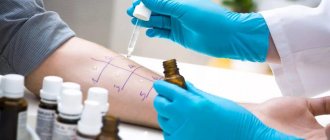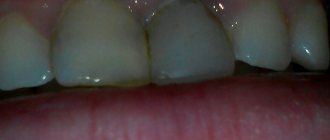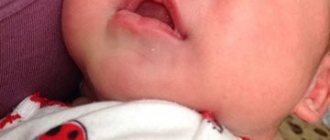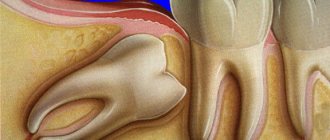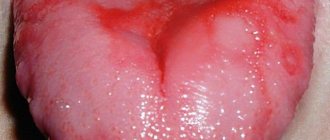Swelling of the upper lip in a child indicates the development of pathological processes in the body that require mandatory treatment.
This article discusses the main causes, symptoms and treatment methods depending on the etiology of edema. Possible complications and prevention of this condition in a child are also described.
Why is my child's upper lip swollen?
A swelling on a child’s lip cannot occur on its own. This signals the emergence of some problems that affect the baby’s health.
To prevent them, it is important to correctly and timely identify the factors that provoked swelling.
Among them, experts highlight:
- It is important to correctly and timely identify the factors that provoked swelling
Allergy, as a reaction to certain foods , oral hygiene products. This is also how the body can react to taking certain medications or the presence of orthodontic structures in the mouth.
- Insect bites provoke swelling of the mucous membranes of the lips, as a result of individual allergies.
- Teething may be accompanied by slight swelling of the baby's lips.
- Traumatic injury. In addition to mechanical damage, a swollen lip in a child can cause frostbite, chapping, or burns.
- Pathologies of systemic viral, infectious or bacterial origin. Most often, the body reacts this way to ARVI, herpes infection, or acute respiratory infections.
- Dental diseases: periodontal disease, stomatitis of any etiology, periodontal disease, periostitis.
- Dentist mistakes. Incorrect treatment or poor quality dental procedures can cause lip swelling.
- Inflammation. This symptom is characteristic of many diseases, or may be a response to a lip injury.
Important! If the swelling of the lip is caused by an inflammatory process, then the presence of accompanying symptoms is mandatory. This may include hyperthermia, soreness and a change in color. Also, depending on the etiology, ulcers may appear on them. - The habit of biting your lip provokes constant mechanical damage, which becomes the main cause of the formation of microcracks and wounds with subsequent infection.
- Hygiene problems. Children begin to learn about the world through their mouths, so it is impossible to maintain proper hygiene of the oral cavity and all objects that the baby puts into his mouth. The entry of bacteria into the mouth provokes the development of inflammatory processes, which can cause the lip to swell.
What is periostitis and how does it manifest in children?
The disease is usually a consequence of advanced dental problems, when inflammation descends, spreading to the bone. In children, this process can happen very quickly - sometimes the hours count.
In everyday life, periostitis of the jaw is called gumboil
. It is usually acute in nature and manifests itself with the following symptoms:
- complaints of jaw pain;
- asymmetrical swelling, puffy cheek;
- enlarged lymph nodes in this area;
- increase in general body temperature;
- weakness of the child, signs of general intoxication.
Please note that with periostitis, cooling the inflamed area reduces pain, and heating
increases discomfort.
Look at photos of children with periostitis - you will notice that the face is asymmetrical, the cheek or cheekbone area is swollen and looks painful.
The symptoms listed above (one or more) should be a guide to immediate action - it is necessary to urgently take the child to the dentist. It should be noted that in this case a prior appointment is not required - at the municipal clinic you will be seen immediately with a note of “acute pain”.
Symptoms
In medical practice, swelling on the lips can be localized in any area. Most often in children, its upper part swells. But, regardless of where the swelling is located, this condition can be a sign of a life-threatening condition.
The appearance of swelling on the upper lip, depending on the etiology, may be accompanied by the following symptoms:
- Regardless of where the swelling is located, these symptoms may be a sign of a life-threatening condition.
The anatomical shape of the lips changes.
- Rapid and sudden development of a tumor.
- The appearance of swelling of the mucous membranes of the tongue and oral cavity.
- There is an unpleasant odor from the mouth.
- Increased pain on palpation of the lip and area under the nose.
- Labored breathing.
- Itching sensation on the lips, throat or mouth.
- The skin began to darken and acquire a blue tint.
- High body temperature, chills, fever.
- Sensation of a foreign object in the throat.
- There may be small pimples and blisters on the lips.
Important! If a child shows the slightest sign of swelling on the upper lip, it is necessary to immediately seek qualified medical help. The specialist will be able to correctly determine the cause of swelling and prescribe appropriate treatment to stabilize the child’s condition.
Associated symptoms and what do they indicate?
In addition to the main symptoms, swelling of the lips in a child is always accompanied by additional symptoms.
According to the accompanying manifestations, the diagnosis is made easier:
| Sign | What does it indicate? |
| Temperature | The development of both general and local hyperthermia indicates an infectious etiology of the disease and the appearance of inflammation. |
| Only the middle of the lip is swollen | The formation of an abscess as a result of mechanical trauma to the soft tissues and pulp of the tooth. |
| My lip is very swollen | For the occurrence of an allergic reaction in the form of Quincke's edema, disruption of the functionality of the salivary glands, or severe injury and insect bites. |
| Swollen lower lip | For the appearance of neoplasms of various etiologies, the development of angioedema or allergic edema. And also for mechanical injury to the integrity of the lip. |
| The lip is festering | This sign is a symptom of bacterial infection of the oral cavity, the development of purulent stomatitis, cheilitis, type 1 herpes, or the presence of closed acne. |
Important! Regardless of the visual signs, to make an accurate diagnosis it is necessary to undergo a full examination, which includes laboratory testing.
Treatment of stomatitis and cheilitis in children
Among diseases of the red border of the lips and oral mucosa in children, the most common are aphthous stomatitis and cheilitis.
Stomatitis, in turn, is divided into acute, subacute and recurrent. The pathological process can be represented by erythematous, vesicular-erosive, ulcerative or necrotic forms. The etiological and pathogenetic causes of stomatitis are very different, including mechanical damage to the oral mucosa.
However, as some authors note, aphthous stomatitis, which has an infectious-allergic nature, is more common. Clinically, it is manifested by the appearance of a round (up to 1 cm in diameter) inflammatory element in the form of a spot with a bubble on the surface, which eventually opens and forms erosion with rounded outlines, very painful, grayish-white or yellowish-gray in color.
The erosion is surrounded by an inflammatory ring; it heals within 1-7 days, leaving no traces. When the infiltrate is located around the salivary gland, the aphtha is represented by an ulcer with infiltrated edges and bottom; it heals within 2 months, leaving behind scars. Relapses of the disease often occur in the spring and autumn. The severity of the disease can increase over time: the number of aphthae increases and the duration of their healing reaches 2-4 weeks, relapses become more frequent. In children, this process is often accompanied by gingivitis and periodontitis.
Cheilitis is more common in children suffering from atopic dermatitis. The process involves the red border of the lips and the skin of the perioral area - this lesion is called atopic cheilitis. The area of the corners of the mouth is most affected, but the process never affects the oral mucosa. Patients initially experience itching, erythema with clear boundaries and swelling of the red border of the lips. Crusts may appear at the site of scratching. The symptoms of acute inflammation quickly subside, giving way to lichenification of the lips. The surface of the red border of the lips peels off with small scales and is cut by thin radial grooves; the skin in the corners of the mouth remains infiltrated for a longer time, which leads to cracks.
Treatment of this pathology, especially in children, should be comprehensive; Particular attention should be paid to the sanitation of foci of chronic infection in the oral cavity. Local therapy should include analgesics, antiseptics and epithelializing agents. Since the effectiveness of conventional drugs used in the treatment of aphthous stomatitis and atopic cheilitis is not high enough, we tried to find a drug that increases the effectiveness of therapy and is approved for use in children. Tablet forms of metronidazole have long been used in the complex treatment of gastritis, gastric and duodenal ulcers in pediatric practice, as well as in the treatment of amoebic dysentery, to stimulate reparative processes. The effectiveness of these drugs is explained by the possibility of influencing Helicobacter pylori and the gastritis caused by it [1].
The effectiveness of metronidazole in the treatment of periodontal diseases has been reported by a large number of authors. The drug turned out to be effective in the treatment of diseases associated with anaerobic flora, protozoa and bacteria; in addition, normalization of obligate flora in the oral cavity was noted [2, 3]. Good tolerability of topical oral metronidazole in combination with systemic antibiotics has also been reported in many studies.
The composition of the Metrogil Dent gel includes metronidazole, which has the above properties, as well as the antiseptic chlorhexidine, effective against gram-negative and gram-positive flora, lipophilic viruses, yeast and dermatophytes [4]. This combination explains the high effectiveness of the gel in the treatment and prevention of infectious diseases of the oral cavity. And since one of the reasons for the occurrence and recurrence of aphthous stomatitis is infection and, in addition, the duration of cheilitis, as a rule, depends on the addition of a secondary infection, the choice of this drug in the treatment of these diseases is the most optimal.
The convenience of using the gel in children is also due to the fact that the auxiliary substances included in its composition are menthol and sodium saccharin, which give the gel a pleasant sweetish menthol taste, and therefore the application of the gel does not cause negative emotions in children.
We use Metrogyl denta gel in the treatment of aphthous stomatitis in children. We observed 19 children with recurrent aphthous stomatitis aged 5 to 16 years. The drug was prescribed 3 times a day for aphthae. After applying the gel, patients were not recommended to rinse their mouths or eat food for 30 minutes. The effect was observed on the second day and was expressed in a decrease in pain and inflammation. Epithelization was observed within 3-5 days. As a rule, the process occurred against the background of diseases of the gastrointestinal tract and oral cavity, most often it was biliary dyskinesia and gingivitis. Thanks to the administration of Metrogil Denta gel for 10 days, 1 time at night, on the gums in 11 children, there was no relapse of the disease for 6 months. In 5 patients, the drug was used for primary aphthous stomatitis against the background of skin pyoderma, the effect was observed on the 3-4th day.
For cheilitis, the drug was prescribed to 15 children aged 5 to 15 years.
The drug was applied to the areas of inflammation 2 times a day, epithelization of the cracks occurred on the 4-5th day, after which the drug was taken once a day in combination with ceralin for 2 weeks. This combination of drugs made it possible to quickly stop acute manifestations of cheilitis, reduce itching and infiltration in the corners of the mouth, which made it possible to avoid the reappearance of cracks.
All patients had good tolerability of the drug, no side effects were observed, and in children of the younger group, application of the drug did not cause any negative emotions.
Based on the above, we can conclude that the use of Metrogil denta gel in the treatment of aphthous stomatitis and atopic cheilitis in children allows you to quickly and effectively cope with the acute manifestations of this pathology, avoid frequent recurrences and the addition of a secondary infection. In this regard, the drug can be recommended for use in pediatric practice as a highly effective remedy for the treatment of stomatitis and cheilitis.
Literature
- Guide: diagnosis and treatment of internal diseases. Medicine, 1999, vol. 3, p. 88.
- Ainamo J., Lie T., Ellingsen BH et al. Clinical responses to subgigival application of metronidazol 25% gel compared to the effect of subgigival scaling in adult periodontitis // J. of Clinical Periodontology. 1992. 19P12/: 723-9.
- Pedrazzoli V., Killian M., Karring T. Comparative clinical and microbiological effect of topical subgigival application of metronidazol 25% dental gel and scaling in the treatment of adult periodontitis // J. of Clinical Periodontology. 1992. 19/9P12/: 715-9.
- Baby N., Al Jasser N. Subgingival irrigation effect of chlorhexidine or sunguinarine and gingivitis in orthodontic patients // J. of Clinical Pediatric Dentistry. 1996 Spring. 20 (3): 225-8.
Diagnostics
To make an accurate diagnosis and identify the causes of the disease in case of swelling of the upper lip in a child, it is necessary to undergo a timely medical examination.
If rapid swelling occurs, you must urgently call an ambulance or consult an allergist yourself. This condition is dangerous because swelling of the throat can develop, which can result in asphyxia, which can be fatal.
If swelling appears gradually and is accompanied by additional sensations, to eliminate them, you may need the help of doctors such as:
- An examination by any doctor begins with a visual examination.
Dentist.
- Pediatrician.
- Infectious disease specialist.
- Maxillofacial surgeon.
- Otolaryngologist.
- Oncologist.
An examination by any doctor begins with a visual examination. Then, taking into account the clinical picture, specialists prescribe a series of examinations.
Among them it is worth highlighting:
- Laboratory tests: clinical blood test, flora smear, general blood test, biopsy, biochemical blood test.
- Hardware examination: radiography, ultrasound, MRI or computed tomography.
Important! Timely and complete diagnosis of the pathology will allow you to choose the right treatment. This will significantly reduce the child’s recovery time.
What to do if your child has a swollen lip?
Many people, especially young mothers who are having their first baby and don’t have any experience yet, panic and begin to figure out what to do if the child has a swollen lip?
There are quite a few cases where a child’s lip is swollen due to an allergic reaction. If the mother knows what the child may be allergic to, it is necessary to protect her baby as best as possible from sources of irritation. If there is no such knowledge, then it is worth analyzing what the child ate. Especially note the new, just introduced food products. Assess whether the baby has been in contact with animals, poultry, household chemicals, or maybe it is an allergy to indoor dust. If you are unable to identify the source of irritation on your own, an allergist will help in this situation. After conducting test tests, he is able to accurately determine the “culprit” of children’s discomfort. The doctor usually recommends protecting the baby from the allergenic source and prescribes an antihistamine. For example, suprastin, zyrtec, kestin, cetirizine, claritin.
This is interesting: Official instructions for use of Tantum Verde - indications and contraindications for use
The antiallergic drug Cetirizine is developed as a selective antagonist of H1-histamine receptors. Its main characteristics are excellent antiserotonin, anticholinergic and sedative properties. It is used as a drug that effectively relieves itching, swelling and has anti-inflammatory properties. Cetirizine is not addictive. For young patients, the attending doctor mainly prescribes it in the form of drops or syrups. The amount of active substance administered directly depends on the child’s age and body weight. The medicine is taken under the direct supervision of a doctor.
Toddlers from one to two years old are usually prescribed drops, which are administered in a dosage of five drops twice throughout the day.
Children whose age ranges from two to six years and whose body weight is less than 30 kg are prescribed five drops (or 2.5 ml of syrup, measured with the measuring spoon included in the package). The drug is administered twice throughout the day. Or 10 drops (or 5 ml of syrup) once, immediately before the baby goes to bed.
For older children, from six to twelve years old, weighing more than 30 kg, the drug is administered in the amount of 10 drops (or 5 ml of syrup form), taken twice a day. A one-time administration of the drug is also acceptable, but the dosage is doubled and amounts to 20 drops (or 10 ml of syrup), which are drunk immediately before going to bed.
The administration of the drug is not related to the time of the meal. The duration of therapy is adjusted by the attending physician depending on the form and severity of the allergy and can be either one or six weeks. If a sick patient is diagnosed with a disease that affects the kidneys and/or liver, the amount of the drug is prescribed purely individually, most often this dosage is half as much as the usually recommended therapeutic dosage.
Mostly, the drug in question is well tolerated by the little patient’s body, but in some cases, this medicine should not be prescribed. Such cases include hypersensitivity to the components of the drug and renal failure.
What should you do if your child’s lip is swollen due to dental problems? There is only one answer - immediately contact a pediatric dentist. Only he can understand the problem and solve it. A swollen lip in a child can cause damage to the tooth by certain pathologies, for example, dental caries. If the doctor cleans the tooth and closes the entrance canal with a filling, this may be enough to solve the problem. But sometimes it is the filling material that is the source of irritation, causing allergies, then the baby will have to be patient and have the filling replaced.
Such a reaction of a child’s body can also happen to the process of teething, and if this natural action occurs with an increase in body temperature, it is necessary to urgently seek help from a dentist. The same doctor also solves problems with pathological gum disease.
All children by nature, with rare exceptions, are terrible fidgets. Therefore, if parents notice swelling on their child’s lips, the first thing to do is to remove the possibility of a bruise or blow. If this is the result of just such an injury and the bruise is minor, then it will be enough to apply iodine to the problematic area (just in case, to prevent infection).
If an obvious inflammatory process is observed, pain symptoms appear, a purulent infiltrate begins to form, and an unpleasant odor appears from the wounds. In such a situation, it is worth disinfecting the problem area with hydrogen peroxide as soon as possible. The source of such a wound can be a cut, an accidentally ripped off pimple, or, as a consequence of a blow, a rupture of soft tissue. The affected area should be disinfected and dried with iodine. If there is no improvement, consult a doctor. If the therapy was not carried out efficiently or time was lost, then it may be necessary to open the abscess surgically.
If the reason that a child's lip is swollen is herpes or another infectious lesion, treatment includes antiviral drugs: tablet form or ointment, for example, such as acyclovir.
In the form of an ointment, the drug is applied in a thin layer to the problem area twice throughout the day until the symptoms go away.
If tablets are prescribed for oral administration, the dosage of the drug is determined individually. This indicator is influenced by the patient’s age, severity of the disease and immune status. In case of viral infection by herpes strains, patients over two years of age are prescribed 0.2 g, which corresponds to one tablet taken five times a day. The duration of treatment is five days. For children from one to two years old, the dosage is halved, the number of injections remains the same.
Contraindications to the use of this drug are the age of children under one year and individual intolerance to the components of the drug.
If ulcers are present or inflammation has affected the periosteum, urgent treatment measures must be taken. Otherwise, the inflammatory process can reach the brain tissue, which can be fatal.
Stomatidin is a local antiseptic. The medicine is used undiluted for rinsing or applied to a tampon to wipe the oral mucosa. The drug should not be swallowed. The procedure is carried out two to five times a day for 30 seconds. One procedure takes approximately 10 - 20 ml. Duration of therapy is seven days. Using the medicine in the form of an aerosol, therapeutic procedures are carried out two to three times a day, one to two presses of the nebulizer.
This is interesting: The whole truth about dental treatment in children under anesthesia
While feeding a newborn with breast milk, the baby may experience swelling, which may be caused by improper feeding. When a baby is applied to the mother's breast, the baby may develop a callus in the mouth, which causes discomfort and swelling. It is necessary to reconsider the situation and change feeding tactics. Such data can be conveyed to a young mother by a visiting nurse or local pediatrician.
The baby's bad habit of biting his lips can also cause lip swelling. It is very difficult to get rid of such a problem, but it is possible and even necessary. This habit can be psychological in nature, and is caused by fear and fear. The discomfort in question can also be provoked by secondary factors: a stressful situation, low immune status, hypothermia. In this case, therapy is purely symptomatic.
It cannot be excluded that a swollen lip in a child is a symptom of damage to one or more organs of the gastrointestinal tract.
- Usually, problems of this nature appear suddenly and the sooner you take countermeasures, the faster you can get rid of the unpleasant discomfort. And if the medicine cabinet does not have the necessary medications, then you can use traditional medicine, but then, nevertheless, it is better to see the baby to the doctor.
- Take an aloe leaf and extract juice from it. The age of the plant should not be less than three years (at this time it comes into force). Soak a cotton swab or gauze folded in several layers in the liquid, or wrap the paste, and apply a lotion to the disturbing area for 15-20 minutes.
- The following components are used: Fuller's earth and such an oriental spice as turmeric, taken in equal proportions. Using water, mix the ingredients until a paste-like structure is obtained. The prepared ointment is applied to the problem area and after fifteen to twenty minutes is washed off with plenty of water.
- You can use a beekeeping product. Apply honey to the swelling and leave for a third of an hour. Wash off the remaining honey. The procedure is repeated several times throughout the day.
- Soda is diluted in a small amount of water until it becomes paste-like. The resulting medicine is used in the form of lotions. The procedure lasts ten minutes, after which the residue is washed off with enough water.
- If an insect bites you, you can apply a piece of ice to the affected area.
The happy face of a child is an unspeakable joy for his parents, but if the baby is naughty, the mother is ready to do everything to ensure that her baby returns to a good mood. If a child’s lip is swollen, it is worth taking the first steps of medical care and trying to independently find out the cause of this symptom. But it would still be a good idea to show the baby to the doctor. This step allows you not to miss a more serious disease, which became the source of the swelling. Therefore, take care of your children and be more attentive to them. Good health to the kids and their parents!
Topical products
Local emergency aid for swollen lips in children:
- iodine and brilliant green;
- hydrogen peroxide;
- Acyclovir ointment against herpes (do not use for children under one year of age) (we recommend reading: how to take Acyclovir syrup for children?);
- Stomatidin is an antiseptic mouth rinse;
- antifungal ointments (Lamisil);
- oxolinic ointment (we recommend reading: instructions for use of oxolinic ointment for children).
Preparations for oral administration
The cause of swollen lips can be herpes, which manifests itself in the form of accumulations of blisters with liquid (we recommend reading: how can you treat herpes on the lips in children?). To treat the virus, special ointments and antiviral drugs are used.
After establishing the reason for the swelling of the upper or lower lip, the doctor recommends for oral administration:
- antiallergic drugs: Fenistil, Suprastin, Zyrtec, Cetirizine (for infants);
- antiviral drugs: Orvirem, Rimantadine, Arbidol, Anaferon, etc. (we recommend reading: how to take Arbidol children's syrup?).
Before giving tablets to a child, you need to study the instructions in detail. Many medications have serious contraindications.
Folk remedies
To treat swollen lips, traditional medicine is used, which is effective and safe. Aloe (agagave) will help with the inflammatory process. To do this, take 1 leaf of the plant and squeeze out the juice. Moisten a piece of cotton wool with it and apply to the inflamed area for 20 minutes.
Bee products cope well with inflammation. They can be used for treatment only if the child does not have allergies. It is enough to lubricate a swollen lip with honey several times a day.
Soda lotions are suitable for relieving swelling. Baking soda is diluted with water to the consistency of a thick paste. Compresses with the resulting mixture are made several times a day until the swelling goes away.
What to do if your lip is swollen - treatment, depending on the cause
If there is swelling on the lip, the therapeutic complex is selected taking into account the main factors that provoked this condition in the baby.
The doctor also takes into account the child’s age and his individual physiological characteristics of the body and health in general.
What to do if your lip is swollen:
- The doctor takes into account the child’s age and his individual physiological characteristics of the body and health in general.
Herpes virus , in which the mucous membranes are covered with small ulcers and blisters: treatment with peroxide, furatsilin solution, levomikol ointment.
- An allergic reaction is treated with general and local antihistamines.
- Tramming. The damaged area is treated with a disinfectant. Afterwards, the use of wound-healing ointments, essential oils, and propolis is allowed.
- Dental pathologies and errors are treated exclusively by specialists in a specialized clinic.
Important! In most cases, as a universal aid, if a child’s lip is swollen, doctors recommend rinsing the mouth with antisemitic drugs and herbal decoctions.
How to relieve swelling?
When treating swelling of the upper lip in a child, medical practice uses drugs and traditional medicine that have decongestant, anti-inflammatory, antiseptic, antihistamine, and analgesic effects.
Among pharmacological drugs, particular effectiveness is observed in complex treatment, consisting of oral and local medications:
- Self-prescription and incorrect dosage can not only aggravate the development of edema, but also reduce the overall health of the baby
General drug therapy, depending on the etiology of the cause of swelling , consists of using tablet drugs: Suprastin, Ibuprofen, Rimantadine, Anaferon, Gerpivir.
- Local therapy has a symptomatic effect and stimulates tissue regeneration. Most often in pediatrics, when a child has swollen lips, the following are prescribed: Stomatidin, oxalic ointment, Acyclovir, brilliant green solution, Lamisil, hydrogen peroxide.
- Natural medicines recommended by naturopaths are prepared based on herbal ingredients. Most often in this case they use: aloe juice and pulp, decoctions of medicinal herbs, herbal infusions, beekeeping products, Fuller's earth, baking soda. In addition to the local use of folk remedies, children are recommended to drink herbal teas to strengthen general immunity.
Important! The prescription of medicines and folk remedies should be carried out exclusively by a pediatrician based on the results of the examination. Self-prescription and incorrect dosage can not only aggravate the development of edema, but also reduce the level of overall health of the baby.
Causes of dental periostitis in children
As already mentioned, this disease is usually secondary and caused by inflammatory processes in the teeth (odontogenic periostitis). What problems can lead to damage to the periosteum?
- dental caries with inflammation of the pulp;
- periodontitis;
- injury to the tooth or jaw.
Inflammation from the soft tissue area spreads deeper, involving the periosteum (fluss = “flow” in German, which perfectly characterizes the infection process).
Types of periostitis of the jaw in children
According to the course of the disease, acute and chronic forms are distinguished. It should be noted that the second is very rare.
Acute periostitis in children is usually purulent in nature - exudate forms under the periosteum, significantly changing the shape of the face, making it asymmetrical. Other symptoms of the disease are described above - increased body temperature, complaints of pain, swollen gums, etc. If the gums are soft and loose, then this is a different case.
Any manifestation of inflammatory processes in the teeth and jaws should be a signal to go to the hospital. And acute purulent periostitis
is a signal to provide immediate assistance
.
The chronic form is manifested by an increase in periosteal tissue, which outwardly looks like a slightly asymmetrical jaw. This usually does not cause discomfort to the child. However, you need to consult a dentist - perhaps dental treatment will help remove the source of inflammation, which will lead to a gradual return of the periosteum to its original healthy state.
Which doctor should I contact for flux?
Inflammatory processes in the oral cavity, including periostitis, are treated by a dentist. You can go to a municipal clinic or a private center. In the dental clinic at your place of residence, you will be provided with assistance under the child’s compulsory medical insurance policy
.
If the flux manifests itself on a day off, find the contacts of on-duty municipal clinics in your city. Typically, several offices in different areas are open on Saturdays and Sundays.
Or go to a private clinic. In this case, flux treatment may be a little more pleasant, since such organizations are equipped taking into account the mental characteristics of children. The child may be shown a cartoon during the procedure. The staff of private clinics is specially trained to work with young patients. Prices for the treatment of periostitis should be clarified by calling a specific organization.
How is acute periostitis treated in children?
Treatment of the acute form of the disease is possible only with a doctor. No folk remedies, lotions or rinses can defeat flux - it can only make it worse. Separately, it is worth mentioning the dangers of warming up. Heating the painful area can increase the rate at which inflammation spreads, leading to unpredictable consequences. Warming up the flux is strictly prohibited!
Treatment of acute, including purulent, periostitis in children includes, first of all, opening the abscess and removing pus. The gums and periosteum are cut, under which exudate has accumulated. In some cases, drainage is required. The tip of a latex strip is inserted into the wound, which prevents the incision from closing quickly and allows all the pus to leak out. The procedure seems unpleasant, but it is well tolerated.
The doctor also carries out manipulations aimed at minimizing the source of initial inflammation.
In advanced cases, hospitalization will be required.
Also, after opening the wound, draining and sanitizing the oral cavity, the doctor will prescribe antibacterial therapy, possibly immune-supporting drugs.
Children who have undergone treatment for periostitis are advised to drink plenty of fluids, rest, and eat right.
The diet should contain a sufficient amount of protein, vitamins, minerals - calcium, magnesium, iron and others.
Treatment of chronic periostitis in children
This form of the disease is extremely rare in minors. Treatment of chronic periostitis in children is aimed at removing the source of inflammation, reducing tissue proliferation by activating immune processes. Physiotherapeutic procedures are prescribed; in advanced cases or if conservative therapy is insufficiently effective, surgical intervention is possible.
Possible complications
Most often, a swollen upper lip in a child, with timely and correct medical care, does not pose a danger to the health, much less the life of the child. In most cases, swelling goes away and leaves no negative consequences.
But it is worth noting that neglecting the baby’s condition or not following medical prescriptions can provoke the development of the following negative consequences:
- In most cases, swelling goes away and leaves no negative consequences.
Having a large scar.
- Eczema in an advanced stage.
- Development of sepsis.
- Life-threatening infection.
- The spread of herpes rash not only over the entire lip area, but also on the face.
- Rapid development of Quincke's edema during an allergic reaction.
- The appearance of a malignant neoplasm.
Important! To prevent the development of complications, treatment of lip swelling in a child must begin at an early stage.
Preventive measures
You can easily prevent the development of puffiness on your lips.
To do this, the following preventive measures must be observed:
- Consume exclusively clean foods.
- Keep your hands and mouth clean.
- Drink vitamin complexes systematically.
- During seasonal exacerbations, take antiviral drugs.
- Avoid trampling.
- Have regular dental checkups.
- Treat dental pathologies in a timely manner only from trusted specialists.
- For allergy sufferers, avoid contact with allergens and always carry antihistamines with you.
- Avoid psycho-emotional stress.
- Minimize stressful conditions.
Important! The main thing in preventing swelling of the upper lip in a child is its regularity. Only with this approach is it possible to avoid the appearance or recurrence of this condition.
Swelling of the lip in a child is not always an independent disease. In most cases, this is a clear sign of more serious pathologies. Therefore, if even the slightest swelling occurs, you must immediately consult a doctor.
Why do lips swell?
Mechanical reasons
Various mechanical impacts are one of the most common causes of lip swelling.
The symptom appears as a result of a fall or an accidental or intentional blow to the face. It is characterized by an asymmetry of location, the presence of hematomas and abrasions. Minor injuries with minor local swelling of one lip are the result of damage from a toothpick or dental floss. In some people, swelling occurs as a result of constant self-harm - the habit of biting the lip. Lip burns are usually superficial; in addition to swelling, hyperemia, pain, and sometimes peeling and crust formation are observed. Thermal burns are detected after ingestion of too hot liquids and food, or contact of lips with heated dishes. After prolonged exposure to the sun, sunburn is possible. Chemical burns are often severe and are caused by accidental or intentional use of aggressive substances.
In the summer, the lip may swell due to an insect bite. In women, the symptom often occurs as a result of cosmetic procedures: piercing, tattooing, contouring. Significant swelling of the lips is observed in the first days after plastic surgery: lipofilling, VY plastic surgery, lip shape correction.
Allergic reactions
Allergic cheilitis is most often observed when using lipstick. Other possible cosmetic allergens are contour pencils, lip creams, and toothpastes. Sometimes lip swelling is caused by dentures. Among food products, contact allergies are caused by citrus fruits, pineapples, and some berries.
Chemical industry workers and musicians who use mouthpieces when playing wind instruments may develop occupational allergic reactions. Swelling of the lips may be due to an allergy to an insect bite, which is different from the usual reaction caused by irritants entering the tissue.
Allergic cheilitis is manifested by burning, itching, swelling, redness of the lips against the background of limited erythema at the site of contact with the allergen. Nearby tissues usually remain intact; in some cases, swelling is observed to spread to the oral mucosa and surrounding skin. A more severe form of allergy is considered to be Quincke's edema, in which swelling diffusely spreads to the face, lips, oral mucosa, tongue, pharynx, and larynx.
Atopic cheilitis, which is one of the signs of neurodermatitis, is characterized by a chronic course with seasonal exacerbations. Allergens include medications, pollen, household dust, food products, etc. The first manifestations are swelling and hyperemia, always limited to a red border. Then erythema, peeling, grooves and cracks appear.
Swelling of the lips
Other types of cheilitis
Inflammation of the red border of the lips is accompanied by swelling, redness, peeling, pain and burning. Sometimes complicated by the formation of bleeding ulcers and purulent crusts. Can be caused by the following forms of cheilitis:
- Exfoliative.
Develops against the background of neurotic disorders, hyperfunction of the thyroid gland. Initially, superficial scales appear on swollen lips. Over time, rough, dense crusts form. - Glandular.
Caused by the proliferation of minor salivary glands due to congenital structural features or dental diseases. Swelling and dryness are complemented over time by the formation of deep cracks. - Meteorological.
Associated with increased sensitivity to cold, wind, and ultraviolet radiation. Against the background of swelling, itching, burning, erosions and crusts appear. With a long course, the development of precancerous diseases and lip cancer is possible. - Hypovitaminosis.
It is observed in people with a deficiency of B vitamins, especially -. Slight swelling and hyperemia affect the lips, mucous membranes of the mouth and tongue.
Dental diseases
In dental pathologies, swelling spreads to the lips from adjacent soft tissues and is localized mainly along their inner surface.
- Oral candidiasis.
Hyperemia, swelling and a white cheesy coating are detected on the mucous membrane of the cheeks, lips, palate, and back of the tongue. With the development of candidal cheilitis, maceration, superficial peeling, and the formation of grayish films and crusts are observed. - Stomatitis.
More often the lower lip swells. With catarrhal stomatitis, the swelling is insignificant; with aphthous, ulcerative, ulcerative-necrotic stomatitis, the swelling is more pronounced if the ulcers are located close to the lips, and may be asymmetrical. - Periostitis.
The swelling is one-sided, spreading to the lips from the cheek, accompanied by intense pain and limited jaw movements. - Salivary stone disease.
Swelling of the lower lip occurs when the salivary gland is blocked by a large stone and is a consequence of reactive inflammation.
Viral and bacterial infections
A common cause of asymmetrical limited swelling of the lip is the herpes virus. First, the patient feels a burning sensation, itching, and local swelling. Then a group of bubbles forms in the affected area, which after a few days subside to form a self-falling crust. The pathology is prone to a recurrent course; exacerbations are caused by acute infections, hypothermia, overheating, and decreased immunity.
Erysipelas occurs when infected with beta-hemolytic streptococcus, and is more often detected in patients suffering from caries, diseases of the oral cavity, and diseases of the ENT organs. Swelling is one of the first symptoms of erysipelas; it occurs on the lip, nearby mucous membranes or skin. Accompanied by severe symptoms of intoxication. Then erythema and regional lymphadenitis appear. Subsequent relapses are possible.
Tumors
Swelling is not typical for lip papillomas; it appears when the formations are traumatized. With keratoacanthoma, local swelling may be found around the central funnel filled with horny masses. Manganotti cheilitis at the initial stage is manifested by local edema, hyperemia of the lip, in the area of which an irregularly shaped erosion forms. Subsequently, swelling is absent or slightly expressed. In case of lip cancer, swelling is more often found in patients with an ulcerative form of the disease, when the tumor disintegrates.
Rare pathologies
Rare causes of the symptom include Melkersson-Rosenthal syndrome, accompanied by recurrent swelling of the lips. During an exacerbation, the lips enlarge 2-3 times, become dense, bluish-elastic, and turn out, exposing the mucous membrane. Swelling of neighboring areas is possible: cheeks, eyelids, tongue. Other signs are facial neuritis and folded tongue.
Other reasons
Swelling of the lips and face can be observed in acute infectious diseases and other conditions accompanied by general hyperthermia. Another possible cause of swelling of diffuse swelling, including in the lip area, is somatic pathologies with fluid retention. Sometimes swelling is observed against the background of hypothermia or, conversely, exposure to high ambient temperatures.



